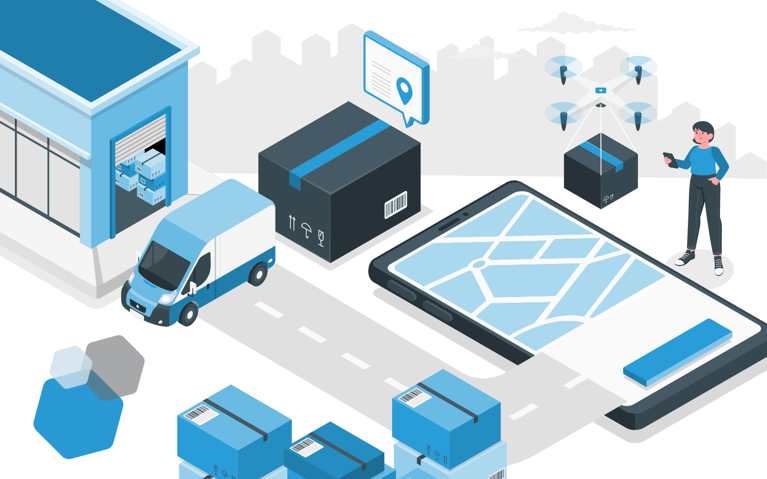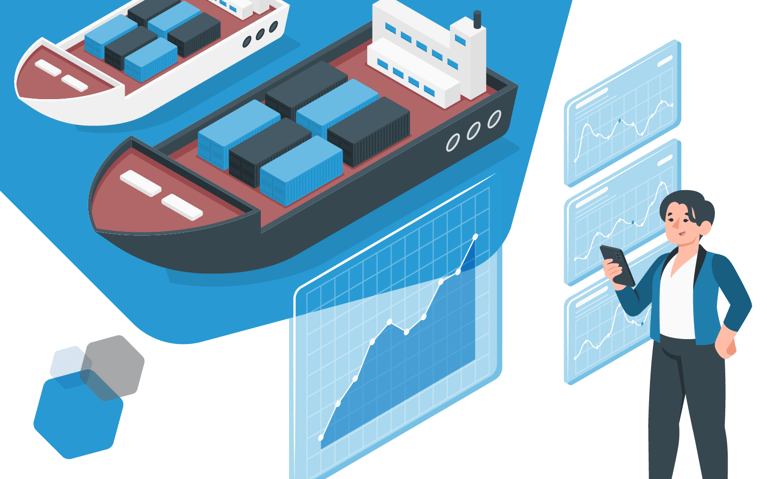Originally posted 1/26/2023, updated 2/1/2024 by A. Wolfe
Omnichannel fulfillment is often one of the biggest challenges that brands must handle. Today’s customers expect to get their orders quickly and have real-time visibility into their order’s progress. A slow or opaque fulfillment operation negatively impacts your customer's experience.
Streamlining your order fulfillment and inventory management processes gives you the transparency, reliability and speed required to get packages to your customers swiftly and accurately. One way to accomplish this is to automate and increase the efficiency of your fulfillment process by using a pick and pack system.
The pick and pack workflow
A pick and pack workflow is a fundamental process within the logistics and ecommerce ecosystem, seamlessly bringing products from warehouse shelves to the hands of customers. This workflow is the backbone of efficient order fulfillment, ensuring accuracy, speed and customer satisfaction.
The pick-pack-ship workflow includes the following steps:
- Receive order: The process begins when a customer purchases through an ecommerce channel. Ideally, your selling channels are integrated with your fulfillment software, and once your customer places an order, a packing slip is automatically generated in the warehouse.
- Pick order: Using the packing slip, a picker sources the product from the warehouse. There are many options for picking methodologies, and the best one depends on several factors, including the size of your ecommerce business and the amount of inventory you're managing. As your inventory grows, your storage system will become more complex, and automation will become more important. Your picker may work from individual packing slips or a pick list, which increases efficiency. Pickers may be responsible for all your inventory, or they may be responsible for smaller sections, instructed to decrease wasted movements. After your picker finishes gathering the current orders, they take them to the packing area along with the packing slips.
- Pack order: The packer sorts items into orders, packs them into the appropriate packing material and labels them for shipping. The packer double-checks the order and ensures that everything is included. Once finished, the order is ready to ship. If you use more than one carrier, your orders will be sorted by the carrier and readied for pickup on the loading dock.
- Ship order: Your packages will be picked up by the carrier. They'll then be tracked until they reach your customers. The shipping designation in your software will update the sales order and adjust your inventory levels.
Elements of a pick and pack system
Although the overall concept of pick and pack is simple, consider the variables to optimize efficiency. You may start with a simpler pick and pack system and transition to different methods to reduce mistakes and conserve resources as your business grows and expands its omnichannel fulfillment efforts.
4 Common pick methods
The optimal pick method depends on the number of orders you receive daily.
Piece picking
Piece picking is ideal for businesses that typically ship a small volume of items. It’s a method in order fulfillment where individual items, or "pieces," are manually selected from storage locations to fulfill customer orders. Unlike bulk or case picking, where larger quantities are retrieved at once, piece picking involves selecting individual items one by one. This method is also commonly used in ecommerce and retail settings where orders consist of diverse products, sizes or variations, requiring a more detailed and customized approach to assembling the order for shipment. Piece picking is known for its flexibility and suitability for handling a wide range of products in diverse order compositions.
Batch picking
Batch picking is an order fulfillment strategy where multiple orders are picked together in a single trip through a warehouse or fulfillment center. Instead of picking one order at a time, warehouse workers gather items for several orders simultaneously, organizing them into batches. This method improves efficiency by reducing travel time and maximizing productivity, particularly in environments with a high volume of smaller orders. Batch picking is widely used in ecommerce and distribution centers to streamline the picking process and enhance overall order fulfillment speed and accuracy. Fulfillment software (WMS/OMS) is essential if you're using this method.
Zone picking
Zone picking is an order fulfillment method where a warehouse is divided into distinct zones, and each picker is assigned to a specific zone. When an order comes in, it is divided into zones, and individual pickers are responsible for selecting items only within their designated area. Once all items are picked from each zone, they are combined to fulfill the complete order. Zone picking is particularly effective for large warehouses with a diverse range of products, as it optimizes the picking process by reducing travel time and increasing overall efficiency in fulfilling customer orders.
Wave picking
Wave picking is an order fulfillment strategy where multiple orders are grouped together into "waves" based on common characteristics such as location, product type or order priority. During each wave, warehouse workers pick items for several orders simultaneously, streamlining the picking process and improving efficiency. This method allows for a more organized and systematic approach to order fulfillment, often resulting in faster processing times and increased accuracy. Wave picking is commonly used in distribution centers and ecommerce warehouses to handle high order volumes and diverse product assortments.
What is an "Order Management System" (OMS)?
An order management system is the heart of an efficient pick-pack-ship process and serves as a centralized hub designed to handle orders from all your sales channels, including your website, major marketplace, social media platforms and more. It helps you organize, automate and optimize the purchase to fulfillment workflow. An OMS platform not only finds the best way to pick, pack, and ship your orders but also gives insight into every step of the process so you can improve your efficiency using KPIs and find ways to become more cost-efficient.
An Order Management System (OMS) provides numerous benefits for businesses, including streamlined order processing, improved inventory management, enhanced customer satisfaction and increased operational efficiency. It centralizes order-related information, facilitating real-time tracking and visibility across the entire order lifecycle. By integrating with various channels, an OMS ensures consistency in order fulfillment, reducing errors and minimizing delays. Additionally, it empowers businesses to make data-driven decisions, optimize inventory levels, and adapt to changing market demands, ultimately contributing to a more agile and competitive operation.
The order management process
The Order Management System (OMS) process involves receiving, processing and fulfilling customer orders in a seamless manner. It begins with order creation, where customer requests are captured through various channels. The OMS then orchestrates order processing, verifying product availability, determining optimal fulfillment locations and updating inventory levels in real-time.
During order fulfillment, the system facilitates picking, packing and shipping, ensuring accuracy and timely delivery. Throughout the process, the OMS provides visibility and tracking, enabling businesses to monitor order status, manage inventory levels and enhance overall customer satisfaction. The OMS process is designed to centralize and automate order-related tasks, optimizing the end-to-end order lifecycle, including the returns process.
Benefits of pick and pack
Using a pick and pack system and OMS offers your growing company significant advantages, including:
- Faster fulfillment: An OMS can analyze your inventory locations and determine the quickest route. If you have inventory in several warehouses, it can automatically ship an order from the closest one. An OMS can also help you analyze your supply chain for bottlenecks that may be slowing you down.
- Decreased labor costs: An effective system will automate tasks and reduce labor hours previously devoted to order fulfillment. Optimizing your warehouse pick-pack-ship management saves you time and money. Your staff will be freed up to handle tasks that will generate additional revenue for your business instead of routing orders.
- Decreased shipping costs: You can reduce your shipping costs by distributing from the closest locations. Your OMS will automatically find the most cost-effective and fastest method for getting your orders to your customers.
- Reduce excess inventory: An OMS will significantly reduce the need for excess inventory. You can rest easy, knowing that orders received from any channel can be fulfilled without having to keep too much JIC stock on hand. You also don't need to worry about missed sales opportunities because you weren't monitoring your inventory.
- Less redundant data entry: The same information is used across all stages of the order management process. There's no need to input the same information repeatedly. This will cut down on the possibility of errors.
- Increased visibility: Everyone can follow and track order status with an OMS. Your staff will be able to help your customers if any issues arise, and customers can track their own orders through an OMS.
- Data analysis: An OMS can analyze your data to determine how you can improve your operations. It can identify sales patterns, track KPIs and forecast sales and inventory levels.
Choosing a pick and pack system
Although you can manually pick and pack and ship from even your spare closet, that won't be feasible as your business grows. Additionally, the main benefits of using a pick and pack system lie in using its associated OMS.
Cart.com provides a best-in-class OMS and strategically placed nationwide fulfillment centers to help you optimize your order fulfillment and provide a top-notch customer experience. Whether you're shipping direct-to-consumer, wholesale or business-to-business, you can use Cart.com to decrease your costs and scale your business. With Cart.com, you'll always know exactly how much inventory you have in stock and track every order from start to finish. Contact our team of omnichannel fulfillment experts today to find out more.
About the Author

Lars Anderson
Vice President of Fulfillment Sales at Cart.com, Lars Anderson leads sales, marketing and partnership efforts. With a background in early-stage and growth-focused leadership, along with experience in middle-market investment, he specializes in delivering innovative solutions and achieving tangible results.
Read Full BioSubscribe to our emails for the latest industry insights!
By entering your email, you agree to receive marketing emails from Cart.com






